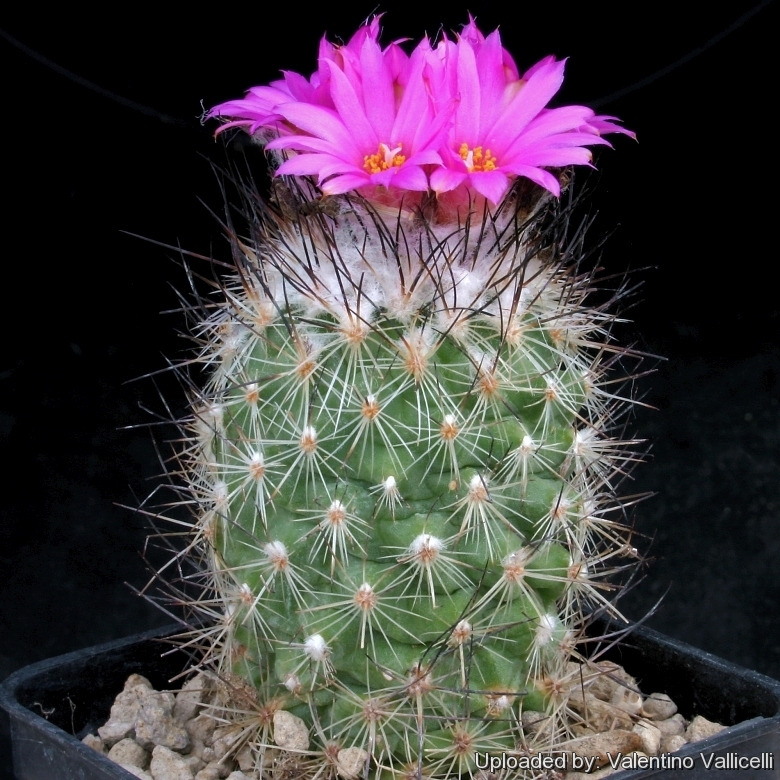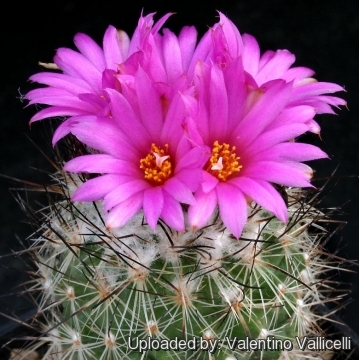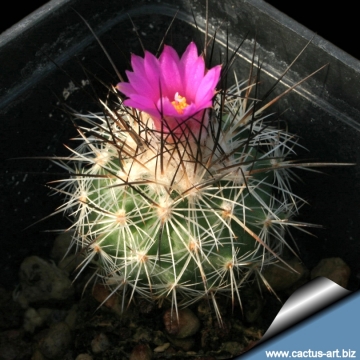
Turbinicarpus viereckii subs. neglectus Photo by: Valentino Vallicelli
Origin and Habitat: Turbinicarpus viereckiiSN|14959]]SN|14959]] subsp. neglectus is extremely rare and the whole population is formed by only a few specimens growing near the town of Jaumave, Sierra Salamanca, Jaumave valley, Tamaulipas.
Altitude: 1000-1300 metres above sea level.
Habitat: This cactus grows in semi-desert (Tamaulipan Shrubland) among calcareous rocks.
Synonyms:
See all synonyms of Turbinicarpus viereckii
back
Accepted name in llifle Database:Turbinicarpus viereckii subs. neglectus D.Donati & Zanov.Con. Cap. Colt. Turbinicarpus – Rapicactus 184 (figs.). 2004 [29 May 2004]
Accepted name in llifle Database:Turbinicarpus viereckii (Werderm.) V.John & ŘíhaKaktusy (Brno) 19: 22. 1983 cf. Repert. Pl. Succ. (I.O.S.) 34: 8 (1985):. 1983Synonymy: 6
Accepted name in llifle Database:Turbinicarpus viereckii subs. major (Glass & R.A.Foster) GlassGuía Identif. Cact. Amenazadas México 1: Tu/vi ssp. major (1998 publ. 1997)Synonymy: 8
back
Description: Turbinicarpus viereckiiSN|14959]]SN|14959]] subsp. neglectus is one of the local or morphological form of Turbinicarpus viereckiiSN|14959]]SN|14959]]. It is an attractive dwarf cactus covered with characteristic glassy white and black spines and whitish wool which is distinguished from the type species for having more numerous, but overall thinner and more flexible spines. The blooms are bright purple.
Habit: Contrary to the standard Turbinicarpus viereckiiSN|14959]]SN|14959]], which often clusters and forms small group with time, subsp. neglectus usually remains solitary (however clumps may be produced in cultivation especially if the plants are grafted).
Stem: Dull green, globose to slightly cylindrical 3-5 (-12) cm tall, 3-5 cm in diameter apex with abundant white wool.
Ribs: 15 to 18 ribs divided in tubercles.
Tubercles: 6 mm long rhomboidal conical.
Central spines: 7 to 9 pale yellowish with black tips rigid to to somewhat flexible, 2-4 cm long thinner than those of other {{viereckii} varieties.
Radial spines: 17 to 22 white translucent, some with brown tips, 0,8-1,3 cm long.
Root: Swollen bundled.
Flowers: Bright magenta or pink and darker mid-ribs, 1,5-2,5 cm long, 12-20 mm broad.
Fruits: Greenish-brown.
Subspecies, varieties, forms and cultivars of plants belonging to the Turbinicarpus viereckii group
 Turbinicarpus viereckii (Werderm.) V.John & Říha: Usually clustered, only 3-4.5 cm in diameter. Radial spines 17-22. Flowers: Magenta: Distribution: valley of Jaumave, Tamaulipas.
Turbinicarpus viereckii (Werderm.) V.John & Říha: Usually clustered, only 3-4.5 cm in diameter. Radial spines 17-22. Flowers: Magenta: Distribution: valley of Jaumave, Tamaulipas. Turbinicarpus viereckii subs. major (Glass & R.A.Foster) Glass: usually solitary, 4-6.5 cm in diameter. Radial spines: 13-16. Flowers: white. Distribution: Nuevo Leon and San Luis Potosi.
Turbinicarpus viereckii subs. major (Glass & R.A.Foster) Glass: usually solitary, 4-6.5 cm in diameter. Radial spines: 13-16. Flowers: white. Distribution: Nuevo Leon and San Luis Potosi. Turbinicarpus viereckii subs. neglectus D.Donati & Zanov.: Usually solitary, up to 5 cm in diameter. Radial spines 16-20, glassy, central spines 7-9, rigid, acicular, yellowish with black tips; Flower: magenta. Distribution: Jaumave valley, Tamaulipas.
Turbinicarpus viereckii subs. neglectus D.Donati & Zanov.: Usually solitary, up to 5 cm in diameter. Radial spines 16-20, glassy, central spines 7-9, rigid, acicular, yellowish with black tips; Flower: magenta. Distribution: Jaumave valley, Tamaulipas.
Bibliography: Major references and further lectures
1) Edward Anderson “The Cactus family” Timber Press, Incorporated, 2001
2) James Cullen, Sabina G. Knees, H. Suzanne Cubey "The European Garden Flora Flowering Plants: A Manual for the Identification of Plants Cultivated in Europe, Both Out-of-Doors and Under Glass" Cambridge University Press, 11/Aug/2011
3) David R Hunt; Nigel P Taylor; Graham Charles; International Cactaceae Systematics Group. "The New Cactus Lexicon" dh books, 2006
4) Davide Donati, Carlo Zanovello “Conoscere, capire, coltivare i Turbinicarpus-Rapicactus” Cactus Trentino Sudtirol, 2004
 Turbinicarpus viereckii subs. neglectus Photo by: Valentino Vallicelli
Turbinicarpus viereckii subs. neglectus Photo by: Valentino Vallicelli Turbinicarpus viereckii subs. neglectus Photo by: Valentino Vallicelli
Turbinicarpus viereckii subs. neglectus Photo by: Valentino Vallicelli Turbinicarpus viereckii subs. neglectus Photo by: Cactus Art
Turbinicarpus viereckii subs. neglectus Photo by: Cactus ArtSend a photo of this plant.The gallery now contains thousands of pictures, however it is possible to do even more. We are, of course, seeking photos of species not yet shown in the gallery but not only that, we are also looking for better pictures than those already present.
Read More... Cultivation and Propagation: Turbinicarpus viereckiiSN|14959]]SN|14959]] subs. neglectus is one of the more difficult species to grow long enough to produce clumps, but if grown correctly, it will reward the grower with generous displays of purple flowers. Keep in shallow and smaller pot than normal. Must have very well draining potting soil.
Watering Needs: Need regular water but do not water again until dry as it is specially sensitive to over watering. Also, it is a species that is dormant in the winter and require very little water (maybe even none) during the cold months.
Frost Tolerance: Somewhat frost tolerant. Light frost protection required. Minimum of 5ºC for safe growing (but hardy up to -5°C or less.)
Sun Exposure: High levels of light are needed to flower and for good spine development. Can be sunburned if moved from shade/greenhouse into full sun too quickly. During the spring it may be able to take full sun until the heat arrives at the end of spring. In an area that has hot afternoon sun, it may be able to take full morning sun, but requires afternoon shade or afternoon light shade.
Propagation: Seeds (usually) or offsets that occasionally appear at the base; leave them attached to form a cluster, or wait until they are 1/3 the size of the parent and then detach and plant.













